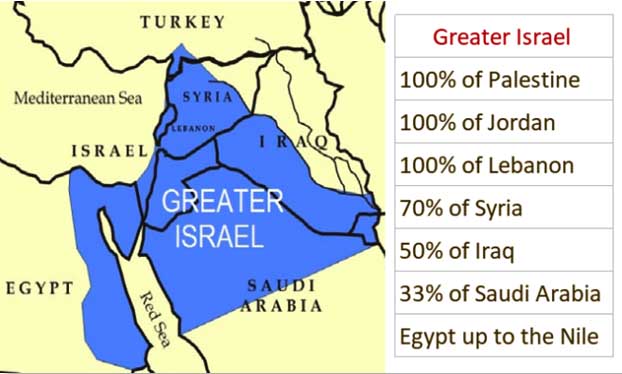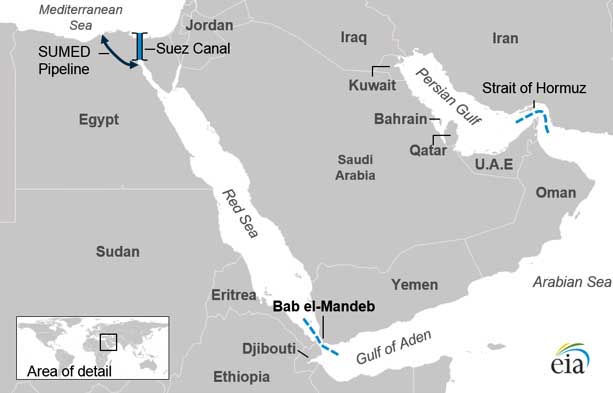
The territorial aspirations of Israel’s religious Right, by no means confined to West Bank settlers who deem the bible a Deed of Entitlement which trumps international law, look for legitimacy to conflictual texts written between the 7th and 1st centuries BCE and collectively known as the Old Testament. Genesis 15:18-21, for instance, defines the land granted them by Jehovah (a self-avowedly “jealous God” with psychotic leanings and not above such collective punishment as visiting the iniquity of the fathers upon the children unto the third and fourth generation) as extending “from the brook of Egypt to the Euphrates“.
Numbers 34:1-15 is less generous. It speaks of land divided between the original twelve tribes of Israel after Moses, with divine assistance, escorted them out of slavery in Egypt. For their part, Exodus 23:29 and Deuteronomy 7:22 promise territory to be given piecemeal to the children of Israel over many years.
So now we know.
*
Part 1 of this three four parter began with the truth that while Benjamin Netanyahu is a prisoner of his far Right cabinet, when it comes to a Greater Israel their only real differences are over the how. As Avi Gil put in the Jerusalem Post on March 5:
Under Ben-Gvir’s duress, Netanyahu must unequivocally retract his false promises from the past, and can no longer feign commitment to the two-state formula. He withstood the heat for years but, now captive to the messianic Right, his genius for concealing the ideology that guides him is collapsing.
I went from there to the game-changing nature of Iran’s missile strike of October 1st …
In its capacity to slice through Iron Dome and David’s Sling, Tehran has telegraphed in sterner terms than those of April that Zionist impunity is over. No Western asset in the Middle East is untouchable. Be it an RAF base in Cyprus supplying intel for the IDF, a US warship in the eastern Med, the oil fields of Arab autocracies, ships in the Hormuz choke point or, indeed, the apartheid state itself – all are vulnerable …
… and concluded with two (or three) questions …
-
How high are the stakes for the US and Israel? (This implies another: to what extent are the secular goals of Washington aligned with the messianic vision of Ben-Gvr and Smotrich?)
-
How high are the stakes for the ‘Axis of Resistance’?
… the first of which I dealt with in Part 2, a “whistle stop” tour of the rise and gradual wane of US hegemony which concluded that:
… it would take years, and extraordinary levels of crisis, for a chastened USA to change course; decades more to implement structural change on the scale needed to forge an economy capable, with dollar and military supremacy things of the past, of standing on its own two feet …
Unless minds less sociopathic than those currently on the loose in Washington can somehow prevail, the temptation to go for broke – in the Iran-Israel stand-off as in the Ukraine and China Seas – will be too great. Since the US has lost, as did Israel on October 1, its former dominance at all rungs of the escalation ladder bar the top one, the signs are not good.
Which is to say the stakes for the US ruling class, in dealing once and for all with an Iran it lost in 1979 with the fall of the Shah, could not be higher. While liberals are yet again co-opted as useful idiots for Uncle Sam over human rights in a country they know nothing about, Iran stays pivotal to Washington regaining the initiative in Central Asia, following its ignominious defeat in Afghanistan and the failed Kazakhstan coup. The better to threaten Russia, disrupt Belt and Road and, most ominous of all for Beijing, put a choke on China’s oil supply through the Strait of Hormuz.

The Strait of Hormuz, 30 miles wide, is the sole sea passage from Gulf States to Indian/Pacific Oceans. Oil tankers carry 17 million barrels a day – 25% of the world’s total consumption, and 50% of China’s – through the Hormuz. (To the southwest is the Bab el-Mandeb choke point, where Yemen’s Ansar Allah operate a partial but effective blockade on Israel.)
Given the allure for US Neocons of regime change in Tehran, the black comedy act of Israel as a mad dog its owner can no longer curb offers a fig leaf of plausible deniability. Which leads me to the first of two questions still outstanding: how far does US policy in the region align with the Greater Israel vision of men like Itamar Ben-Gvr and his private army of West Bank settlers?
In my October 6 post – Does Israel dictate US foreign policy? – I followed better minds than mine in saying:
… this is a chicken-and-egg question [but] while its formidable Lobby is a powerful driver of US foreign policy, Israel enjoys such licence first and foremost because its interests align closely with those of the US ruling class.
Nine days later on October 15 Brian Berletic downplayed the powerful driver part while placing close alignment at centre stage. His 48:30 New Atlas podcast …
… is worth watching in its entirety but most relevant is a remark (in the context of Washington using Israel the way it uses all of its proxies) that America’s Israel lobby is but one of many in a ‘democracy’ sold to the highest bidder. It isn’t even the biggest, best funded or most organised:
People tell me Israel controls the US. When I ask how, they tell me AIPAC. But the arms industry spends far more. So do the Banks, Big Pharma, Big Agriculture. A cartel of industries fund think tanks producing papers which become policies and bills that the media sell to the American people. That’s how it works and the Israel lobbyists are a tiny fraction of that. if Israel truly controlled the US, all its forces would be in the Middle East. But they’re also in Ukraine and South Asia because the US is waging proxy war in all three. [Edited]
He’s the first to my knowledge to bring quantifiability and proportionality to a vexed question. I’m aware of the power of the Israel Lobby but have long been wary of its overstatement, often in anti-Semitic tones, by those fixated on the notion that America Fights Israel’s Wars. If it does, rest assured that’s to advance the interests of US elites. Brian rightly exhorts us to look beyond the specifics of regional tensions to see the imprint – hiding in plain sight in such best-sellers as the 2009 Brookings Report on Options for a New American Strategy Towards Iran, and the blithely prescient candour of the 2019 Rand Report on Overextending Russia – of a dying and by that fact triply dangerous US empire.
In Iran 1953, the US and UK allied with Shia clerics. Not because the ayatollahs ran Washington but because both parties had their reasons for ousting a secularist prime minister, Mohammad Mosaddegh, elected on a ticket of nationalising his country’s oil. In cold war Afghanistan the US armed the Mujahadeen, in the dirty war on Syria it bankrolled Islamic State cut-outs. Because jihadists had captured the US of A? Nope. Because “my enemy’s enemy is my friend” resonates in its deep state. The Mujahadeen loathed Kabul’s land and irrigation reforms, its furthering of women’s rights and its Godless underwriter in Moscow, while Pentagon and CIA saw a way to ensnare the USSR in its very own Vietnam. For their part the Islamists pouring into Syria in 2011 dreamed of a Sunni Caliphate (at least, those who’d read the Qu’ran and weren’t mercenaries did) while Washington’s aims were sketched out in Part 2 when, after summarising America’s laying to waste of Afghanistan, Iraq and Libya (spoilt for choice, I overlooked Yemen) I wrote:
Syria was for me transformative, almost single-handedly inspiring this site. By now even I, slow of uptake, had cottoned on to an empire looking to set the Middle East ablaze in the name of ‘bringing democracy’, and in the ashes build a new regional order answerable to Washington.
At risk of labouring the point, so it was when John McCain shared a platform with fascists in Kiev. (While in the city’s Maidan Square Victoria Nuland was handing out cookies on the eve of ousting the Ukraine’s democratically elected leader, when not making indiscreet calls as to who would/would not get a post in the cabinet of his US puppet successor.) Again, no one is saying Bandera Nazis ran Washington. It suited both to raise hell in the Russian speaking east; the one to assert ethnic supremacy and settle ancient scores, the other to dust off the ‘eighties Afghan playbook (along with the aforesaid 2019 Rand Report) and draw the Russian Federation into a long, costly and on both counts debilitating war.
Of course there are differences of kind and scale between each of my examples and the case of Israel. That’s analogies for you! But I’m with Brian pretty much all the way in saying that when it comes to taming Iran the bible-ordained expansionism of Itamar Ben-Gvr, Bezalel Smotrich and Benjamin Netanyahu dovetails perfectly with the geostrategic aims of an empire “looking to set the Middle East ablaze in the name of ‘bringing democracy’, and in the ashes build a regional order answerable to Washington”.
For each party, war on Iran holds the bold promise of a route out of its considerable difficulties, the perils attendant on such a war notwithstanding. But to gauge the nature and extent of those perils we must consider the last factor of the equation I began with. How high are the stakes for an Axis of Resistance comprising not just Iran but, united precisely by US efforts to avert that very thing, China and Russia?
*
See also:
US Neocons & Israel’s far Right: Part 1
US Neocons & Israel’s far Right: Part 2
US Neocons & Israel’s far Right: Part 3
US Neocons & Israel’s far Right: Part 4
* * *
